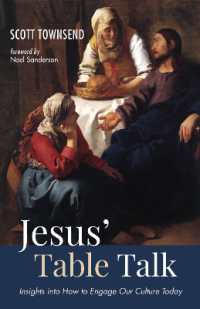- ホーム
- > 洋書
- > 英文書
- > Science / Mathematics
Full Description
Cooperative Wireless Cellular Systems provides an information-theoretic view of the advantages of cooperation in wireless cellular systems.
The impact of cooperation on the performance of wireless cellular systems is studied from an information-theoretic standpoint, focusing on simple formulations typically referred to as Wynertype models. Following ongoing research and standardization efforts, the text covers two main classes of cooperation strategies.
The first class is cooperation at the base station (BS) level, which is also known as Multi-Cell Processing (MCP), network Multiple-Input Multiple-Output (MIMO), or Coordinated Multi-Point transmission/reception (CoMP). With MCP, cooperative decoding, for the uplink, or encoding, for the downlink, is enabled at the BSs. MCP is made possible by the presence of an architecture of, typically wired, backhaul links connecting individual BSs to a central processor (CP) or to one another.
The second class of cooperative strategies allows cooperation in the form of relaying for conveying data between Mobile Stations (MSs) and BSs in either the uplink or the downlink. Relaying can be enabled by two possible architectures. A first option is to deploy dedicated Relay Stations (RSs) that are tasked with forwarding uplink or downlink traffic. The second option is for the MSs to act as RSs for other MSs.
MCP is first studied under ideal conditions on the backhaul links, namely by assuming that all BSs are connected to a CP with unlimited-capacity links. Both Gaussian (nonfading) and flat-fading channels are analyzed, for the uplink and the downlink, and analytical insights are drawn into the performance advantages of MCP in different relevant operating regimes. Performance comparison is performed with standard Single-Cell Processing (SCP) techniques, whereby each BS decodes, in the uplink, or encodes, in the downlink, independently, as implemented with different spatial reuse factors. Then, practical constraints on the backhaul architecture enabling MCP are introduced. Specifically, three common settings are studied. In the first, all the BSs are connected to a CP via finite-capacity links. In the second, only BSs in adjacent cells are connected via (finite-capacity) backhaul links. In the third, only a subset of BSs is connected to a CP for joint encoding/decoding (clustered cooperation). Achievable rates for the three settings are studied and compared for both the uplink and the downlink.
The performance advantages of relaying are analyzed for cellular systems with dedicated RSs and with cooperative MSs. Different techniques are reviewed that require varying degrees of information about system parameters at the MSs, RSs, and BSs. Performance is investigated with both MCP and SCP, revealing a profound interplay between cooperation at the BS level and relaying. Finally, various open problems are pointed out.
Contents
1 Introduction 2 Cellular Models 3 Multi-cell Processing in Gaussian Channels 4 Multi-Cell Processing in Fading Channels 5 Constrained Multi-Cell Processing: Uplink 6 Constrained Multi-Cell Processing: Downlink 7 Dedicated Relays 8 Mobile Station Cooperation 9 Concluding Remarks A Gelfand-Pinsker Precoding and Dirty Paper Coding B Uplink and Downlink Duality C The CEO Problem D Some Results from Random Matrix Theory References








